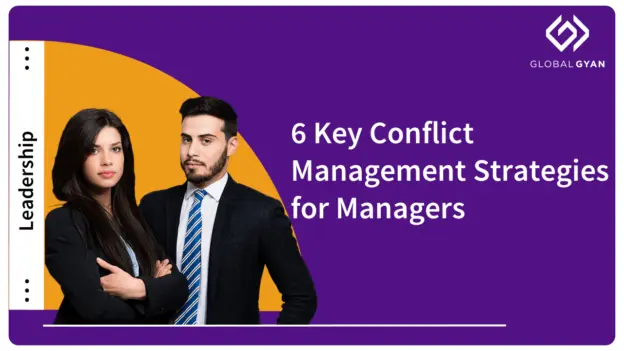6 Key Conflict Management Strategies for Managers


At work, resolving conflicts is a daily occurrence that can either boost or derail an organization’s momentum. Infact at least 25% of a manager’s time is spent on dispute resolution. When managers let conflict develop rather than deal with it directly, the workplace may become too unhealthy and toxic.
Conflict management and Resolution can be a daunting process, especially if you are unfamiliar with the larger ecosystem in which the specific person or department causing the trouble operates.
With the help of effective conflict management and resolution strategies, issues can be resolved swiftly, while strengthening relationships and sparking innovation –at the same time!
In this article, we’ll cover:
The most effective conflict management strategies for managers
- Understanding your team’s makeup
- Define acceptable behaviour
- Accommodating the other person
- Collaborating to find a solution
- Set boundaries
- Manage conflict with care and maturity
1. Understanding Your Team’s Makeup
Having a team meeting to discuss conflict management before an issue arises is one great approach to conflict resolution. While workplace disputes can arise between employees and clients or between employees and top management, the majority of workplace disputes arise between co-workers who spend the majority of their time together. Ask everyone to consider their preferred method of managing disputes daily. Possible areas of agreement may already exist.
2. Define Acceptable Behaviour
By establishing a standard of conduct at work, you can minimise or even completely avoid possible issues before they even have a chance to arise. The team will define what is and isn’t appropriate if you give them the freedom to.
However, as a manager you have the responsibility to set the tone. Writing detailed job descriptions, developing a discussion framework, identifying the hierarchy and who is in charge of what, establishing suitable business procedures, deciding which project management tools to employ, and assisting with team building and leadership development are all ways you may achieve this. The clearer rules & expectations you establish, the better the team will be able to follow them and lesser the changes of disputes.
3. Accommodating the Other Person
Even while some team members aren’t scared to discuss problems, they may never have any expectations of their own. Instead, they go out of their way to meet the expectations of the other party and resolve the problem.
All points of view or pieces of information cannot be presented during a conflict resolution process that is accommodative. People who are accommodating inevitably suppress their anger or minimise their emotions. This might eventually lead to a buildup of frustration and the expectation that outspoken co-workers will always get their way.
In order to foster collaboration, it is ideal to encourage accommodating people to express their demands during conflict management sessions.
4. Collaborating to Find a Solution
Each team member’s capacity for assertiveness and cooperation is maximised through collaboration. When everyone has had a chance to express their requirements, the team works together to do whatever is necessary to address those needs to the maximum extent feasible. Everyone goes home content.
Collaboration may not always be possible, but it is still worthwhile to try. Too frequently, perceptions, miscommunication and misunderstandings lead to disputes. A team can only function in a truly collaborative setting if each member is willing to express their demands and contribute to meeting those of others.
5. Set Boundaries
If you don’t understand the boundaries and restrictions that your employees have, conflict could escalate into something much more difficult to handle. You must be aware of the benefits and drawbacks of handling conflicts within the confines of each of your employees since everyone handles conflict differently.
By carefully observing people, you may help them understand when they are prone to stepping over the line; you can also spot behavioural patterns that seem to inspire particular attitudes, cause mental shifts, or show a lack of self-awareness. This can be achieved by holding regular coaching sessions in which you can start to establish precedent and reaffirm performance standards for each of your staff. This enables you to not only identify their conflict boundaries but, more crucially, to set guidelines that will aid in averting conflict.
Leaders who actively engage in coaching and learning about their team members can greatly reduce conflicts. It is crucial to know your people if you want to understand how they will impact the ecosystem you are trying to create.
6. Manage conflict with care and maturity
Maturity of conduct is paramount for any manager. It is imperative to don a role of a Mentor. Here are few essentials for managing conflict that managers can adopt:
- Acknowledge the problem and try to understand the nature of conflict, without making any assumptions. Most importantly focus on the problem and not the people.
- Stay Neutral and talk to each person, listen to all sides of the story without any bias
- Understand the extent of hostility among employees
- Encourage open communication to resolve the conflict
- Once you have all the above information – give a realistic solution than a quick fix one
- Preferably seek common grounds between the conflicting employees, teams as it is usually more impactful than management led solutions.
- Lastly, have proactive measures like an open-door policy so that people can express grievances privately and find a solution to any conflict before formal interventions.
Final Words
The art of leadership lies in preparing for the unexpected. Avoid adding to the difficulty. Exercise the self-confidence necessary to act.
In order to resolve conflicts, one must recognise the chances that others miss.
Conflict can be a healthy enabler of growth for your organisation and professional advancement for all parties involved when it is resolved with an eye towards opportunity. Effective leaders are aware that it takes some degree of conflict with them before the most genuine connections with their team members, customers, and external partners can start.


